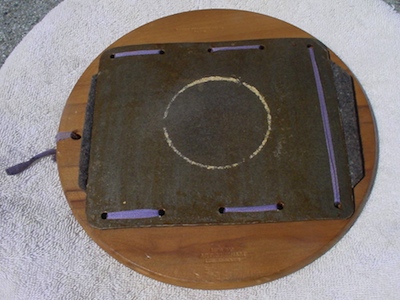| Many drummers today know George Lawrence Stone (1886 - 1967) only as the author of Stick Control, one of the most important method books ever written on snare drum technique. The most brilliant aspect of Stone's book is its simplicity which allows the sticking patterns contained within to be catered to nearly any style of drumming from orchestral to rudimental as well as on drumset. Stick Control was the first of its kind and has shaped the way that virtually all drummers practice today. 100 years ago, George Lawrence was better known as the son of George Burt Stone. The elder Stone was well known as a band director, drummer, teacher, and author, and in 1890 founded George B. Stone & Son. The younger George Lawrence grew his performing career through the early 1900s and 1910s as a member of the Boston Festival Orchestra and Boston Opera Company Orchestra, and as a businessman working as Junior Partner under his father at Geo B. Stone & Son. George Lawrence famously turned down contracts with the Boston Symphony Orchestra and the John Philip Sousa Band in order to tend to his obligations with the family business. When George Burt Stone passed away in 1917, George Lawrence assumed the helm at Geo. B. Stone & Son. George Lawrence would oversee the company through prosperous times in the 1920s, but the company faded through the 1930s and fizzled completely by around 1940. The Stone Company's decline was spurred by many factors including the Great Depression, the advent of talking movies which put theater drummers out of work, and a shift in George Lawrence's focus more towards teaching and writing and away from producing and selling musical instruments. Also, the Stone Company never fully industrialized their manufacturing processes or their equipment on the level that would have been necessary to compete with the larger drum companies of the midwest. Stone's drum manufacturing equipment was eventually sold to Ralph Eames in 1950. |  George Lawrence Stone, ca. 1917 |
The Stone Drum & Xylophone School thrived long after the manufacturing business was shuddered and for many years George Lawrence authored percussion columns in trade publications including Jacobs' Band Monthly and the International Musician. There was no Modern Drummer Magazine or Percussive Notes at that time so Stone's article's were one of the few regularly published resources for drummers. But George Lawrence Stone will probably be best remembered as the author of Stick Control first published in 1935.
Getting back to the descendants of George Lawrence Stone, his surviving grandchildren have recently come together to reclaim the copyrights to their grandfather's books. They have since been working to update old versions and make sure they are easily available everywhere. New re-engraved editions of Stick Control and Accents and Rebounds have already been completed and are available through the new family business, Stone Percussion Books LLC. Next up on their docket is The Dodge Drum Chart which was written by F. E. Dodge in 1908 and later edited and republished by George Lawrence Stone in 1928. The Stone Family is currently in search of an original copy of the book to be used in preparing a new edition. If you have one, you can contact them through their website.
And as always, if you have an instrument made by George B. Stone & Son INC., I'd love to hear from you! Send Lee an email at lee@vinson.net.







